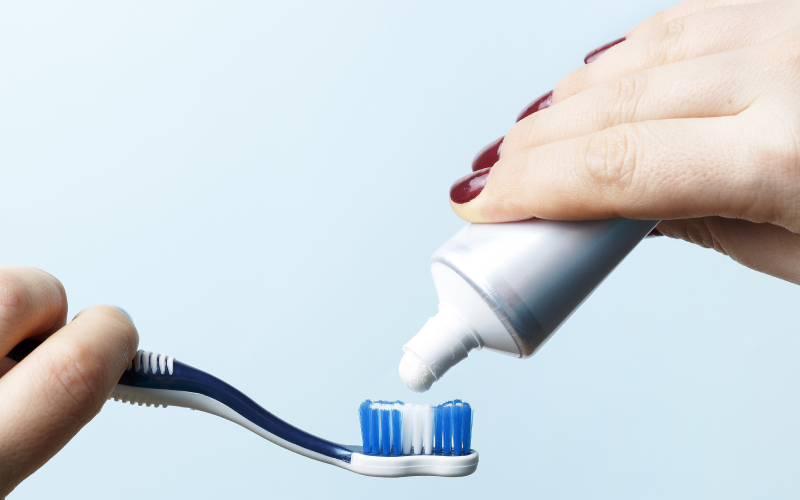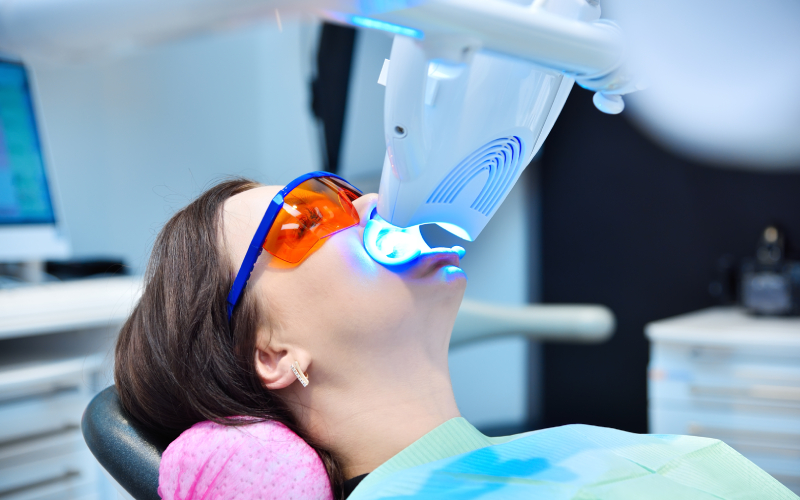Tooth sensitivity is a common issue that many people experience. It is characterized by a sharp, often painful sensation in the teeth when exposed to various stimuli, such as hot or cold temperatures, sweet or acidic foods, or even air. Tooth sensitivity is primarily caused by the exposure of dentin, the inner layer of the tooth, which contains tiny tubes called dentinal tubules. When these tubules are exposed, they allow external stimuli to reach the nerves inside the tooth, leading to discomfort.
This can make it difficult for those who are interested in tooth whitening but are worried about aggravating their sensitivity. Fortunately, however, it is possible to safely whiten, even if you have sensitive teeth.
Causes of Tooth Sensitivity
Several factors can contribute to tooth sensitivity. A common factor is tooth enamel erosion. Enamel is the protective outer layer of the tooth. When it becomes thin or wears away due to factors like acidic foods, vigorous brushing, or tooth grinding, the dentin underneath becomes exposed, leading to sensitivity.
Receding gums can expose the tooth roots, which do not have a protective enamel layer, making them more susceptible to sensitivity.
Cavities, cracked teeth, or dental restorations that don’t fit correctly can expose dentin and lead to sensitivity. Trying to lighten teeth with broken teeth or cavities is painful and will aggravate the dental problem.
Some over-the-counter (OTC) teeth whitening products may cause or exacerbate tooth sensitivity in individuals with pre-existing sensitivity issues. This includes cases when tooth enamel is thin, and an abrasive OTC whitening product like a whitening toothpaste that works by scrubbing away surface stains removes enamel as well, or if bleaching products are too harsh or contact the gums.
Avoid Over-the-Counter Teeth Whitening Products
People with teeth sensitivity should exercise caution when considering over-the-counter (OTC) whitening treatments, such as abrasive toothpaste, which can potentially exacerbate their condition. Tooth sensitivity often results from worn enamel, receding gums, or exposed dentin. These whitening products frequently contain abrasive ingredients like silica or baking soda, designed to scrub away surface stains. However, the abrasive nature of these substances can lead to enamel erosion, making teeth even more susceptible to sensitivity.
In addition to abrasive toothpaste, teeth whitening strips and gels can also pose risks for sensitive teeth. These products often contain peroxide, which can penetrate the tooth’s surface and irritate the nerve, causing increased sensitivity and discomfort.
It’s crucial for individuals with teeth sensitivity to consult a dentist before pursuing any whitening treatment. Dentists can recommend safer alternatives, like professional in-office treatments or custom-made at-home kits, which are gentler on sensitive teeth.

Professional Teeth Whitening for Sensitive Teeth
Professional teeth whitening, often known as in-office teeth whitening, is a safe and effective option for individuals with sensitive teeth.
Customized : A dentist can tailor the whitening process to the individual’s specific needs. They will consider the level of sensitivity and adjust the whitening products and procedure accordingly.
Gum Protection: Dentists take steps to protect the gums and soft tissues in the mouth, minimizing the risk of gum irritation or damage during the whitening process.
High-Quality Products: Dental professionals use professional-grade whitening agents that are more effective and less likely to cause sensitivity compared to OTC products.
Supervision and Monitoring: Dentists closely supervise the entire whitening process, ensuring that it is progressing safely and effectively.
Immediate Relief: In some cases, professional teeth whitening can provide immediate relief from sensitivity, as it seals the dentinal tubules, reducing the likelihood of discomfort in the future.
How Professional Teeth Whitening Works
Professional teeth whitening typically involves the use of hydrogen peroxide or carbamide peroxide as the active whitening ingredient.
Before beginning the procedure, your dentist will examine your teeth and assess your oral health, then discuss your goals and concerns. It’s important to mention your sensitivity issues. This will allow your dentist to customize the treatment plan to your specific needs.
In some cases, sensitivity may be due to a dental issue, such as tooth decay; in these cases, the issue is identified and treated before beginning whitening.
Your dentist will consider the best approach to minimize sensitivity while achieving the desired whitening. This might involve using desensitizing products before or during the whitening process, using lower-concentration whitening gels, or spacing out treatments to allow for recovery between sessions.
Teeth Whitening Options
Your dentist may recommend either an in-office procedure or take-home trays, or you may be able to choose either, based on your preferences.

In-Office Whitening Method
Your dentist will use a protective barrier or gel to shield your gums and oral tissues from the whitening solution, and then apply the professional-grade whitening gel to the teeth. In some cases, a special light or laser may be used to activate the gel and enhance its effects.
The Phillips Zoom In-office Whitening is a popular method used by dentists.
Throughout the treatment, your dentist will closely monitor your progress and make adjustments as needed to ensure the best results while minimizing sensitivity.
After the treatment, your dentist will provide instructions for post-treatment care, which may include avoiding certain foods and beverages for a specified period.
Take-Home Trays Method
- Your dentist will provide you with custom-fitted trays that are designed to fit your teeth precisely, unlike OTC trays. This minimizes the contact of the whitening gel with the gums, reducing the risk of irritation or sensitivity.
- At-home treatments usually allow for a slower and more gradual whitening process which may be recommended for sensitive teeth and may lead to reduced sensitivity during and after treatment. You can also decide when and for how long to use the whitening trays, adjusting the treatment to suit your comfort level and sensitivity.
- Professional Oversight: Even with at-home treatments, a dentist provides guidance and ensures the proper use of the products. They can monitor your progress, address any concerns, and make adjustments as needed.
Advantages of Professional Teeth Whitening for Those with Sensitive Teeth
Professional teeth whitening offers several advantages for individuals with sensitive teeth:
Minimal Sensitivity
Professional whitening is designed to minimize sensitivity by using customized treatments and high-quality products. Your dentist can adjust your formulation as required for your sensitive teeth, and can use other techniques, such as using a desensitizing treatment.
Speed and Effectiveness
In-office whitening procedures provide rapid results, often achieving a noticeably brighter smile after a single session, so you do not need to apply multiple treatments to your teeth.
Long-Lasting Results
Professional teeth whitening typically delivers longer-lasting results compared to over-the-counter products, so you can go longer in between treatments.
Safety and Supervision
The presence of a dental professional ensures that the procedure is safe and effective, with any potential issues addressed immediately.
Tailored Treatment
The treatment plan and concentration of the bleaching agent is personalized to your unique needs, addressing sensitivity concerns, unlike an over-the-counter treatment that is not customized to your situation.
For individuals with sensitive teeth, achieving a brighter smile through teeth whitening is possible, but it’s recommended to professionally brighten under the supervision of a dentist for safety and to help reduce discomfort.


